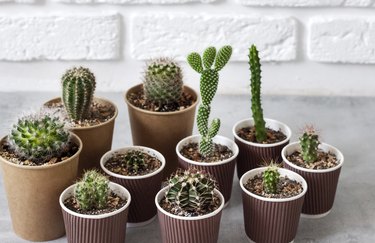
The wide variety of shapes and textures available make cacti attractive additions to both houseplant collections and landscapes. Many species of cacti (family Cactaceae) may be purchased from nurseries in various sizes, but you can also grow your own from seed. Knowing how long it takes to grow a cactus can help you better understand your plants, which can, in turn, lead to healthier cacti that are ready to thrive.
Tip
Most cactus species are slow growers. After an initial growth spurt, they generally grow between 1/3 inch to 1 inch per year.
Video of the Day
Growing Cacti From Seed
You'll need to begin with some potting soil that's suitable for cacti and succulents. The main requirement is drainage, so you may wish to mix your soil with some sand. Waterlogging a cactus can be hugely detrimental to the plant's growth, so you should also select a pot with good drainage.
Video of the Day
Sprinkle your cactus seeds of choice over the top of your potting soil. Use your seeds fairly sparsely and allow adequate space between them. Over the top of your seeds, add a thin layer of fine vermiculite to cover the surface. Spritz the mix with water until it's lightly moist. You should then cover your pot with a plastic bag and leave it in a warm area, like a greenhouse or a particularly sunny windowsill.
Over the next few weeks, you'll begin to notice seedlings. Once you see them, remove the plastic bag and gently spray your pots with water. Keep your seedlings moist but never overly soggy. Over the next few months, your seedlings should begin to resemble baby cacti. They are then ready to transplant to individual pots.
Cactus Care for Growth
Cacti are generally known to be low-maintenance plants, but there are certain things you can do to help boost their growth. Their individual pots should have the same well-draining potting mix that you used to start the seeds. Plenty of sunlight is also key to help cacti grow, so selecting a south-facing or west-facing windowsill is ideal.
Controlling the temperature of your cacti can also help them grow faster. Keep your cacti warm (between 65 and 85 degrees Fahrenheit) during the summer and slightly cooler (45 to 55 F) in the winter months. Your cactus may benefit from spending some time outdoors in the summer but make sure it isn't burned by too much direct sunlight.
Cacti don't require too much watering, particularly during the dormant winter months. Allow your potting soil to dry out between waterings. You can also use a low-nitrogen fertilizer on your cacti once per month during the growing season between March and September.
Growing Cacti Outdoors
Cacti can also be transplanted outdoors to create a feature in your garden. You'll need to prepare your planting area by mixing equal parts of a potting mix that's suitable for cacti in with the native soil. Dig a hole that's as deep and 1.5 times wider than the root ball of your cactus, and make sure you plant it with the north side of the plant facing north. Fill in around the base with potting mix to stabilize your plant, and water lightly. If you want your cactus to live outdoors year-round, make sure that the species you've transplanted is hardy in your climate zone.
How Long Does Growth Take?
After a year, your cactus should be around the size of a large marble. The first couple of years is when your cactus will grow the fastest, generally reaching an inch or two in height during this period. After this initial growth spurt, most cactus species will grow between 1/3 inch and 1 inch per year.
There are some faster-growing cactus species. Ferocactus species (zones 9-10) grow 3/4 inch to 1 1/2 inches per year, for example. Even more impressive is the saguaro cactus (Carnegiea gigantea, zones 9-11), which can grow up to 12 inches a year in the right conditions, sometimes reaching heights of over 75 feet.